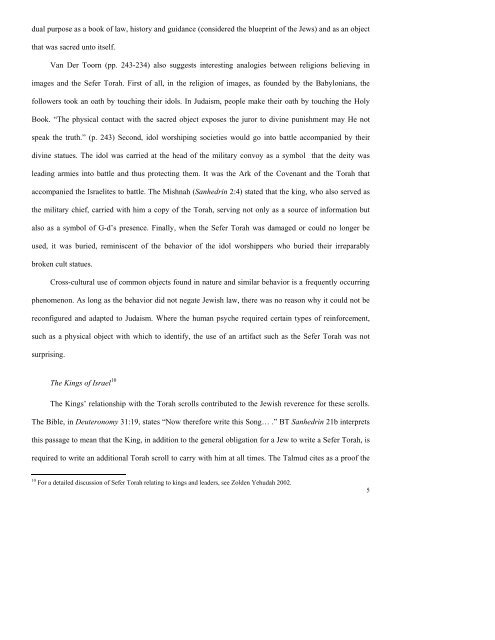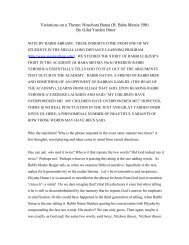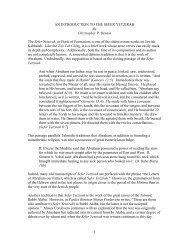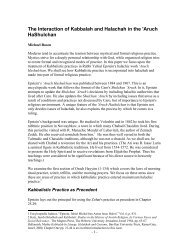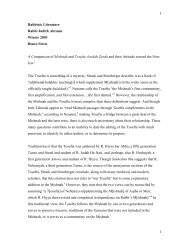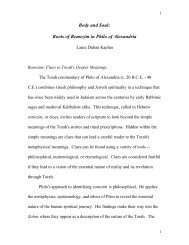The Symbolic Representation of the Sefer Torah - Maqom
The Symbolic Representation of the Sefer Torah - Maqom
The Symbolic Representation of the Sefer Torah - Maqom
You also want an ePaper? Increase the reach of your titles
YUMPU automatically turns print PDFs into web optimized ePapers that Google loves.
dual purpose as a book <strong>of</strong> law, history and guidance (considered <strong>the</strong> blueprint <strong>of</strong> <strong>the</strong> Jews) and as an objectthat was sacred unto itself.Van Der Toorn (pp. 243-234) also suggests interesting analogies between religions believing inimages and <strong>the</strong> <strong>Sefer</strong> <strong>Torah</strong>. First <strong>of</strong> all, in <strong>the</strong> religion <strong>of</strong> images, as founded by <strong>the</strong> Babylonians, <strong>the</strong>followers took an oath by touching <strong>the</strong>ir idols. In Judaism, people make <strong>the</strong>ir oath by touching <strong>the</strong> HolyBook. “<strong>The</strong> physical contact with <strong>the</strong> sacred object exposes <strong>the</strong> juror to divine punishment may He notspeak <strong>the</strong> truth.” (p. 243) Second, idol worshiping societies would go into battle accompanied by <strong>the</strong>irdivine statues. <strong>The</strong> idol was carried at <strong>the</strong> head <strong>of</strong> <strong>the</strong> military convoy as a symbol that <strong>the</strong> deity wasleading armies into battle and thus protecting <strong>the</strong>m. It was <strong>the</strong> Ark <strong>of</strong> <strong>the</strong> Covenant and <strong>the</strong> <strong>Torah</strong> thataccompanied <strong>the</strong> Israelites to battle. <strong>The</strong> Mishnah (Sanhedrin 2:4) stated that <strong>the</strong> king, who also served as<strong>the</strong> military chief, carried with him a copy <strong>of</strong> <strong>the</strong> <strong>Torah</strong>, serving not only as a source <strong>of</strong> information butalso as a symbol <strong>of</strong> G-d’s presence. Finally, when <strong>the</strong> <strong>Sefer</strong> <strong>Torah</strong> was damaged or could no longer beused, it was buried, reminiscent <strong>of</strong> <strong>the</strong> behavior <strong>of</strong> <strong>the</strong> idol worshippers who buried <strong>the</strong>ir irreparablybroken cult statues.Cross-cultural use <strong>of</strong> common objects found in nature and similar behavior is a frequently occurringphenomenon. As long as <strong>the</strong> behavior did not negate Jewish law, <strong>the</strong>re was no reason why it could not bereconfigured and adapted to Judaism. Where <strong>the</strong> human psyche required certain types <strong>of</strong> reinforcement,such as a physical object with which to identify, <strong>the</strong> use <strong>of</strong> an artifact such as <strong>the</strong> <strong>Sefer</strong> <strong>Torah</strong> was notsurprising.<strong>The</strong> Kings <strong>of</strong> Israel 10<strong>The</strong> Kings’ relationship with <strong>the</strong> <strong>Torah</strong> scrolls contributed to <strong>the</strong> Jewish reverence for <strong>the</strong>se scrolls.<strong>The</strong> Bible, in Deuteronomy 31:19, states “Now <strong>the</strong>refore write this Song… .” BT Sanhedrin 21b interpretsthis passage to mean that <strong>the</strong> King, in addition to <strong>the</strong> general obligation for a Jew to write a <strong>Sefer</strong> <strong>Torah</strong>, isrequired to write an additional <strong>Torah</strong> scroll to carry with him at all times. <strong>The</strong> Talmud cites as a pro<strong>of</strong> <strong>the</strong>10 For a detailed discussion <strong>of</strong> <strong>Sefer</strong> <strong>Torah</strong> relating to kings and leaders, see Zolden Yehudah 2002.5


